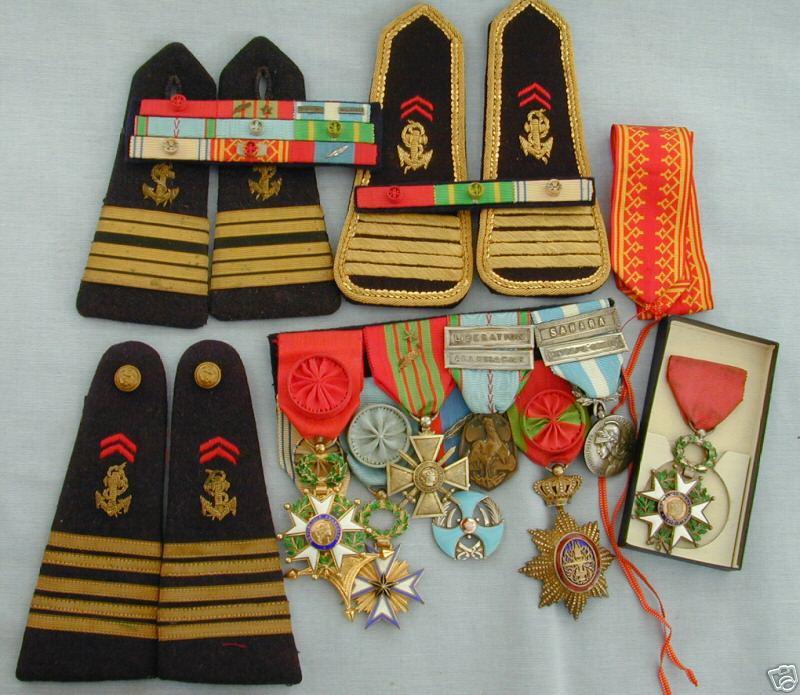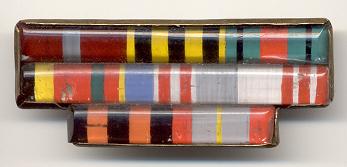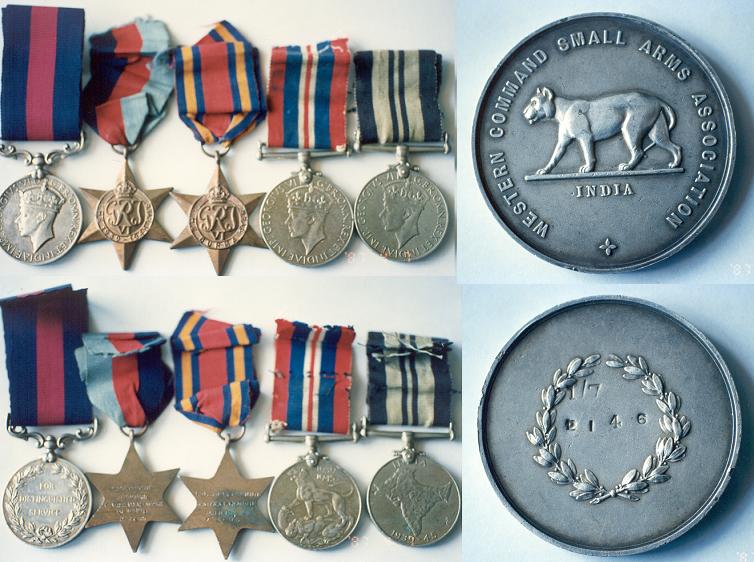-
Posts
2,123 -
Joined
-
Last visited
-
Days Won
3
Content Type
Profiles
Forums
Blogs
Gallery
Events
Store
Posts posted by Paul L Murphy
-
-
Here is an interesting French Group I recently purchased. Unfortunately the seller did not know the name of the recipient but I am hoping the unusual combination will enable me to pin him down at some stage.

The recipient was a colonel in the Colonial Infantry. Apart from his French awards he also has the Officer of the Order of Saharian Merit, Officer of the Order of the Black Star of Benin, an Iranian order (Ed's help on the details of this would be appreciated) and Officer of the Order of Cambodia. The Commander of the Million Elephants and White Parasol is missing from the photo but I have got one since that I will add to the group for display purposes.
If anyone has any information that could help me pin down the identity of the recipient I would appreciate it. I guess the Iranian order could be key to this since I presume it was the sort of gong given to military attaches and the like ?
Enjoy,
Paul
 0
0 -
The photo in 13 is a very nice example of a General's full dress uniform, not Imperial Guard. As far as I am concerned you can keep all the grubby field gear with battle stains, just give me a nice pre war dress uniform like this with lots of glittery things hanging on it !
0 -

Well done that man !
0 -
They are not Komsomol badges, they are Young Pioneer membership badges. Komosomol was open to youths from about the age of 14 onwards whereas the Young Pioneers were the organisation that younger children joined (I think from about 6 but may need to stand corrected). The badge on the left is the standard membership badge. The motto says "Always prepared".
Regards,
Paul
ps. These are attractive, but very common, badges.
0 -
A large chunk of the OMSA's raison d'etre is about to disappear. In fact, it is about to become a criminal offence ! As an OMSA member I obviously find that disappointing, however as a non-American there was precious little I could do to persuade any congressman of the stupidity of the act. All a great pity.
0 -
This is amazing ! All that will happen is that collecting will be driven underground, as in Russia, and it will be even more difficult for people to get access to decent information, learn from experienced collectors, and access good quality material. But of course none of that will hold any importance for the muppets who drafted the law.
How do US collectors intend to react ?
0 -
Well folks, I am now the new proud custodian of Lt Parfiry Kuliba's Red Banner. It has found a good home

Paul
0 -
This is one of my favourite little Imperial bars, even though most of it is private purchase trinkets from the 1920's. I have two groups with these "battle bars", probably better described as service bars since they mention the general theatre of service rather than specific engagements. I am just curious if the more experienced collectors of Imperial items could advise on how scarce these bars are since I have not seen them turn up often ?

Paul

 0
0 -
The indiginous people in the last post are called Ainu. They were forced ever northwards by Japanese settlers until they ended up in the northern part of Hokkaido. Interesting culture, they worshipped bears among other things.
In post 3 he appears to be wearing a Chinese order on his medal bar after the Rising Sun. Can we have a close-up of it ???
 0
0 -
Here is another litttle painted beauty. Starts off with the Red Star and has the ribbon to represent the 25th Anniversary Badge as the second last item. What confuses the hell out of me is the third ribbon on the first row. It looks like the British Defense Medal and I cannot find anything Soviet that in any way resembles it. Anybody got any ideas what it is ?


 0
0 -
Sen-sho on the left (has a gilt finish on the obverse), Ko-sho on the right (silver obverse finish). The Sen-sho is for wonds of a combat nature while the Ko-sho was for non combat wounds or illness.
They are difficult to find without crazing in the enamel since the enamel used has tended to crack over the years, presumably due to the effects of heat and humidity.
0 -
No Comment
in Japan
Of course the other possibility is that the two guys in the photo are both 3 feet tall
 0
0 -
Very interesting, and bloody expensive !
This is what we would have called a 5th class, now known as "gold and silver rays". The writing on the lid of the box makes no mention of numerical class at all so it would appear that all the lid inscriptions have been changed.
Presumably this also applies to new boxes for the Rising Sun as well so start grabbing those post war plastic boxes without the post and catch and with numerical classes on the lid since they are no more !
I hope to visit Japan in spring next year so I will have a good look around to see what the market prices are for these new orders. It is also interesting that the manufacturing technique regarding the red jewels has changed. Originally this was a seperate piece held on by four rivets, then sometime around the late 70's or early 80's they started making a one piece Sacred Treasure, which can be identified by the lack of rivet heads on the reverse. On these new style orders the band appears speerate and is held on by two rivets.
From the photos the quality looks good but I still want to hold one for myself !
Many thanks for sharing these with us.

Paul
0 -
After I get back to London I can provide photos of WWII Purple Hearts, both the army type and the early navy type made from gilded silver. I also have some of the more recent awards, 1991 surplus etc. that I can photograph as well.
0 -
I will send you high res pictures of the Sen sho and Ko sho badges, as well as the document that went with them. I will also have a look through any images I used for my own book and see if there is anything that is wound related. I also have the next of kin medal and related document for Japanese KIA which I will also send.
I also have one of the earlier shield shaped sen-sho badges but I will only be able to send a photo when I relocate to London early next year.
Cheers,
Paul
0 -
I wonder how many forum members would make the "Gold".... at the moment I could MAYBE scrape a bronze... but I would have to put a chili pepper in between my butt cheeks before I ran....

Chris,
I think you will find a rolled up newspaper with one end set alight is a far greater motivator ! Basically the idea is to reach the finish line before the flames start to burn more than the paper.

Paul
0 -
Hi folks,
I suggest you all wander into the lounge and take part in the latest lottery. I am giving away an April 1940 Rising Sun 8th Class certificate.

Paul
0 -
Gerd,
Excellent idea. I would stick with perspex rather than glass, less chance of breakage, chipping etc. Also, rather than having parts of it in wood I would have the entire stand in perspex so that all you see is the order.
Alternatively, have the wood stained black and black coating on the perspex so that the entire stand is black and the order stands out in contrast against it.

Paul
0 -
Gordon,
I have the Sen Sho, but not the Ko Sho but unfortuantely I do not have a decent photo of it. I will be back in Ireland over Christmas and I will try to dig it out and take a photo. If not, I will try to sort one out after I move to London in January.
It is actually quite a small badge, and very very difficult to find.
Regards,
Paul
0 -
Nice one as well Gordon. I actually still do not have one of these in my own collection since I have always ended up selling the one that I get ! I need to hold onto one of them at some stage.
0 -
It is the "small kite" version. A nice find, these are very difficult to get hold of.
0 -
I cannot comment on the jacket and trousers since they are not my area but the beret is correct for Algerian period, it has the same markings as one that I have from the 4th combat company of the 2 REP in the early 60's.
The wings were issued in 1962 which is the year after the 1 REP were dishonourably disbanded for their part in a coup against the French government. The unit badge for the 1 REP was used between 1955 and 1961. They were made by both Drago and Courtois in a number of different strikings.
In short, while all the pieces are correct I would suggest it was put together since the wings from 1962 and the 1 REP unit badge cannot belong together. A member of 1 REP would have got his para qualification before that date.
I hope that helps.
Paul
0 -
Hi Ed,
I knew you would like it

All five medals are named. If you can dig out any more information I would appreciate it.
Cheers,
Paul
0 -
This is one of my favourite groups awarded for fighting against the Japanese (Yes, I sit on both sides of the fence). It consists of a Indian Distinguished Service Medal, 1939-45 Star, Burma Star, War Medal, India War Medal and Western Command India Small Arms Association Silver Shooting Medal. They were awarded to Havlidar Harhabahadur Limbu of the 1/7 Gurkha Rifles.
The citation for the IDSM is dated LG 28/10/42 and reads : -
This NCO was the Pl Hav of the left Pl in the counter attack by B Coy 1/7 GR at Kyaukse on 29 Apr 42. This platoon was to cross a stretch of open ground to gain a road which was known to be held by the enemy. He was seen to dash across the open and threw grenades into a culvert with great effect killing at least 4 Japs. After leading his sec over the open, he went over the ?????? To which the road ran within 50 yards of the enemy and threw grenades into a nullah which was the only covered line for the enemy withdrawal. He then came back for more grenades and again went over. Throughout the action he showed great bravery and controlled his men well, using his initiative to great effect and was instrumental in causing heavy casualties upon the enemy.
This action took place as the Allied forces were retreating from the advancing Japanese. The action action at Kyaukse is described by General Slim in Defeat into Victory (pages 84 to 86) as follows :
In Kyaukse, we found 48 Brigade settled into a strong defensive position. The small town had been badly bombed and burnt out; many of its inhabitants with their cattle were lying dead in the
streets. It was surrounded by paddy fields giving a good field of fire, but there were banana groves and some thick jungle on the banks of the river that ran round the southern and western outskirts. Brigadier Cameron, commanding 48 Brigade, had four weak battalions of Gurkhas, twelve guns, a troop of anti-tank two-pounders, and some Sappers, in all about eighteen hundred men. He was not strong enough to occupy the whole of the long pagoda-dotted ridge that ran out from the town to the east, but in true mountain warfare style he had placed picquets along it. While we were there, the last of the Chinese, footsore stragglers, were being passed through. Cameron had infantry in lorries and a few tanks well to the flanks and to the south to help bring in 63 Brigade, due that night, and to ambush any Japanese who might follow. I left feeling 48 Brigade would give a good account of itsel? It did.
During the night, 63 Brigade with its tanks came through and moved on to hold the Myitnge crossings. Early on the 29th, flank patrols had brushes with armed Burmans and rescued more Indian refugees, but not before some had suffered atrocities. There was a brisk little action between our own and Japanese tanks, some ten miles down the main road, in which one enemy tank was destroyed and ours were bombed from the air. However, with the arrival of large Japanese reinforcements, our detachments fell slowly back to Kyaukse. At 2200 hours in bright moonlight, the Japanese launched a fierce attack on our positions astride the road. The Gurkhas held their fire until their yelling assailants were a hundred and fifty yards away and then let them have it. The attack withered away, leaving many dead. At midnight, a Japanese column of motor transport and bullock carts blundered almost on to our defences, and was heavily shelled and mortared. Half an hour later another attack was met with close-range fire and destroyed. At 0515 hours next morning in pitch darkness, a third attack was flung back in confusion. At dawn on the 30th April, tanks and Gurkhas sallied out and cleared a burnt-out village in front of our lines. Many Japanese in it were killed and several mortars and light automatics captured. The Gurkhas were particularly pleased at trapping thirty-eight of the enemy who had taken refuge in a culvert under the road. The enemy belonged to the 18th Division-one we had not previously met. The general opinion in 48 Brigade was that, compared with their old opponents, the 33rd Division, these newcomers were much inferior in both courage and fighting skill. The Japanese throughout the day shelled our positions heavily but not very effectively, except Brigade Headquarters which they appeared to have located exactly. It was clear during the 30th that the whole 18th Division
was deploying for a renewal of the attack and that the usual out-flanking movements were starting. The brigade was, therefore, ordered to withdraw through 63 Brigade that night. At 1530 hours yet another attack was repulsed, at 1700 hours our men were dive-bombed but suffered no casualties, and at 1800 hours they pulled out covered by one battalion and some tanks. 48 Brigade embussed in the dark a few miles up the road and then went straight through, across the Ava bridge to Myinmu. The action at Kyaukse was a really brilliant example of rearguard work. It not only enabled the last of the Chinese to cross the Ava bridge without molestation and gave us all a breathing space, but it inflicted heavy casualties on the enemy at extremely small cost to ourselves.
What I particularly like about this is that the specific small unit action is mentioned in the book written by the army commander. How often does that happen !

 0
0




French Colonial Officer Group
in France
Posted
Here is a close-up of his "foreign" awards.